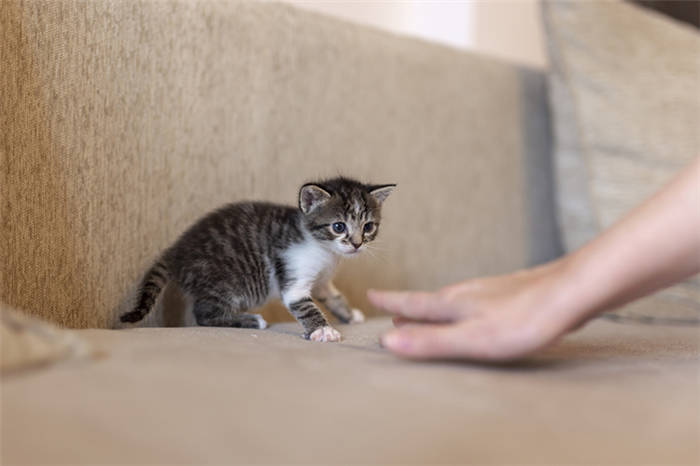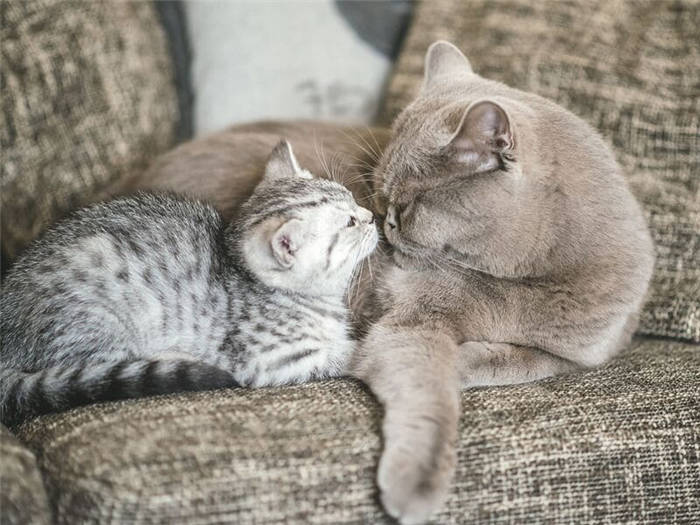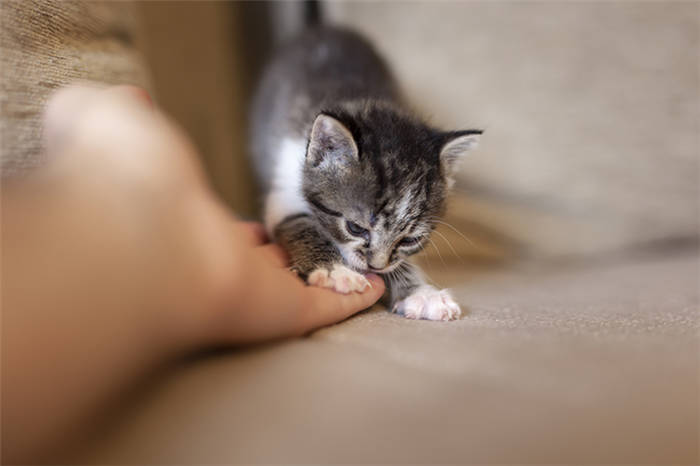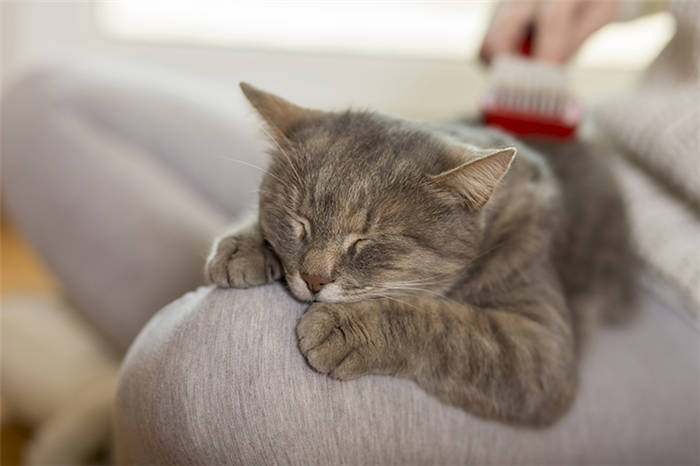This is the author's cat, Fuhrer, with his new kitty, Bullet, lying on his favorite frayed chair

- How do you make friends with an adult cat(s) and a kitten?
- How to prepare for a new kitten
- Calm down your senior cat.
- Prepare your home
- How to get a cat used to a kitten
- First week
- Encourage time together
- How to tame an adult cat? 11 steps.
- How to deal with aggression?
- Rules for the owner
- How to make friends with adult cats: my experience of solving the problem (I took a cat from the shelter, I wanted the best, but it turned out…)
- Encourage shared time together.
- This will encourage mutual activity.
- Interactive toys for cats and cats with treats
- Let the cat establish a hierarchy
- Allow your cat to establish a hierarchy
- Getting an adult cat accustomed to a dog bed
- How to train a kitten to a cot
- What do experts recommend?
- Domesticating a outdoor kitten
How do you make friends with an adult cat(s) and a kitten?
Let's say you already have an adult cat . . And suddenly, after some deliberation, you decide to get another pet and buy a kitten. How to make the first acquaintance of two cats went smoothly? How do they make friends, that they accepted each other and reconciled to the fact that they will have one owner for two? Here are 8 simple tips. Follow them and your pets won't fight:
1. The day before a kitten comes into the house "bribe" your adult pet with a new scratching post, catnip-scented toy, or different treats. Put him in a good mood.
2. When you bring the kitten in allot him a room to live in for about two days. Place bowls of water and food in the corners, place toys and remove small and breakable objects from the room: a kitten is a kitten. It is not necessary to let an adult cat into this room. Let him smell the kitten for the time being, but not see it.
3. The next day, make it so that the kitten and the adult The next day make the kitten and the adult cat smell each other. Let the cat poke its nose into the gap between the door of the "kid's" room and the floor. This way he will remember the new scent and begin to get used to it.
4. Mix the cat's scents: take a wet towel and wrap the kitten in it, then rub the adult cat with this towel.
5. The kitten has been living in your home for two or three days. . Now it's time to swap places with the adult cat. The older cat should be isolated in the room where the kitten lived, and the baby should be given complete freedom – let him get acquainted with the apartment.
6. Put the kitten in a carrier, and let him through its mesh door to communicate with an older companion. A hiss from an adult cat will mean roughly the following: "Hey, buddy, I'm in charge here, remember!" Don't make a big deal out of it.
7. Show the kitten that the older cat is in charge. At first give him first food, and give him the best toys. After a while, you can show the animal that you love them equally.
How to prepare for a new kitten
Preparation is the key to successfully accustoming your cat to a kitten. If you prepare your cat for her new arrival and make the changes less drastic, she is more likely to adjust to her new roommate. Give yourself (and your senior cat) plenty of time to prepare for this adjustment by following these steps.

Calm down your senior cat.
There are pheromones that can be used to create a peaceful environment for any cat. A few weeks before a new kitten arrives is a good time to use them. Diffusers, sprays and wipes are available to help your cat relax without medication. Try using pheromones for at least a few weeks before you bring your kitten home.
If you suspect your cat will be stressed and anxious about a new kitten, consider supplements that are designed to calm the cat. These won't poison your pet with medicine, but they will help them calm and relax. They usually work best when administered a few weeks before the anticipated stressful event, and can be continued after the new kitty arrives. Ingredients usually include L-theanine, phellodendron, magnolia, whey or milk proteins and other natural ingredients that have been shown to be safe and effective for pets.
Prepare your home
Before the kitten comes home, you need to put new items such as food bowls, beds, another litter box and toys in and around the house. Start putting these items in their new places a week before you need to accustom the cat to the kitten, so your cat can get a feel for them and get used to all the new things. If you can, try including items that already have the kitten's scent on them. Make sure you are ready to meet the kitten. If you are stressed and unprepared, your old cat may notice this and negatively affect it.
How to get a cat used to a kitten
Although an old cat sometimes accepts a new kitten right away, it usually takes some time to adjust to the change. Sometimes cats never fully accept a new kitten, they just coexist by staying away from the other cat in the house. It's important to make sure that no matter how your cat feels about the new kitty, things remain calm and that you have a better chance of establishing a friendship from the beginning.
First week
When you bring the kitten home, let the cat smell it while it is in its cage or in your arms. Go straight to the previously assigned room, groom your new kitten and let him explore. His litter box, food bowls, bed and some toys should be easily accessible. Don't let the older cat have access to the kitten unsupervised.

At night, when you are not home and you cannot watch the kitten and the older cat, keep the kitten in a designated room with the door closed. When your cat gets curious, she can stick her foot under the door, sniff under the door and listen to the kitten. Do this for about a week, depending on how your cat behaves with the change. Remember to pay close attention to your older cat after playing with him. They will need your attention and support, and the smell of kitty on your clothes will help them get used to the newcomer.
Encourage time together
After a week, allow the kitten to explore the house under your close supervision. Allow your older cat to observe this exploration and remove herself if she so desires. Don't force the interaction between cat and kitten. If your cat has a favorite interactive toy, such as a feather stick or laser pointer, try playing with both cats at the same time. This will encourage mutual activity. You can also feed them treats at the same time and feed them from different bowls at the same time. Make sure there is enough space between the feeders so that your older cat doesn't feel threatened.
How to tame an adult cat? 11 steps.
Prepare the house for the arrival of the pet. Protect windows and doors, remove dangerous objects from floors and shelves, and insulate cables and outlets.
The cat will need its own cat house: it may be a simple box with bedding, a cot, or a special cat house. A cat cage is best. You can put in it and the house, and bowls, and a litter box. The cage is very helpful in the first stages of training and later. In it the pet is always safe.
A cat will feel safe quicker if the light in the room is dimmed and if it's quiet. Try to create as cozy and quiet an atmosphere as possible.
How long will it take for the cat to adjust? It all depends on the individual cat. Sometimes you only need a few hours, sometimes a few days or weeks.
Allow the cat to rest peacefully in its shelter. Don't take it out of the house, don't try to pick it up. For the first 3-4 hours it is better not to disturb the cat at all. Leave it alone with itself. Don't forget to put a bowl of water and a litter box in the room.
After 3-4 hours offer the cat to eat. It's great if she will come to the bowl immediately and start eating in your presence. But if the cat is afraid, leave the room for a while, so that it eats alone.
Do not look at the cat straight in the eyes, do not try to "over-eye" it. This will turn the cat against you.
A new home is stressful for the pet. Even more stressful is having to deal with unfamiliar people and animals.
If possible, shield the cat from contact with other family members. At first it has to get used to the new surroundings and to one person – the owner.

Gradually spend more and more time around the cat. Don't touch her if she is not ready for this. Just go about your business, talking quietly to your cat. You don't have to talk either. Work at the computer or read a book, so the cat can see you. Your task is to accustom her to your company, to show that you do not threaten her in any way.
How to deal with aggression?
You should be prepared for the first meeting of a kitten and a cat. If you know how the "old-timer" may behave when you see a baby, you will be able to think of ways to act. First, cats can hiss at kittens. And this is a perfectly normal reaction. That's why it's best to start getting to know them from a great distance. If you notice that your pet wants to show aggression to the newcomer or has already tried to pounce, there is no need to scold her. It is a natural instinct, based on the need to protect its territory and the fear of being kicked out. In this case, we recommend that you play with your pet, feed her and give her more time. Next, we'll look at how you can train cats to treat kittens well.

Rules for the owner
The unkindness of an older pet is usually smoothed out. In order not to harm the bonding process, it is important to show patience and equal treatment of both. If you decide to get a kitten as a second pet, you can use the advice of experts:
- Give an equal amount of time to both animals. Cats can also be jealous and, unlike humans, are unable to distinguish their feelings. So they do as their instincts dictate;
- Unequal attention is fraught with anger and aggressiveness of the old pet. She should not feel that she is forgotten;
- A great way to make kittens and cats friends is to play together. So, for example, you can start spending time with them alternately, but leave the door open. Then you should entice both of them. You can even buy toys that will be comfortable for several animals to play with at once.
If you have a cat at home, slightly different rules apply. If your cat is spayed, his hunting instincts show up on a lesser level. This means that there will be less chance of aggression.
How to make friends with adult cats: my experience of solving the problem (I took a cat from the shelter, I wanted the best, but it turned out…)
Cat lovers are sometimes faced with a situation where the desire to get another pet is met with a determined response from the pet. The cat categorically does not want to share its territory with any newcomers, whether it be a small kitten, a cat of the same age or an individual of the opposite sex.
Often this situation quickly and safely resolves itself within a few days. But sometimes….
Yes, such a problem has formed for me as well. Some people will think that this is nothing: cats will sort themselves out. I also thought so at first, but this tense (to put it mildly) situation lasted almost 2 months! So, I want to share my "findings", how to make friends with two adult cats in one apartment.
I looked up a cute "girlfriend" for my adult cat at the shelter. I thought that a young cat would brighten up my Tasya's boring everyday life.
I dreamed of a rosy picture of a happy cat's life. My girlfriend would encourage Tasya to move and play, and she, in turn, would share her feline "experience" of life. Both will take care of each other, as Tasya used to do with her mommy, who lived to a ripe old age. An idyllic picture!
The shelter cat, two-year-old Margo, won me over with her gentle disposition, sociability and curiosity.
This lively and cheerful green-eyed cat trusted me right away. At the shelter Margosha climbed into the carrier and quietly dozed in it all the way while we were driving in the car. When we arrived home, I let her out of the carrier, and here it began!
I didn't think that my quiet and even a little bit cowardly Tasya would act like that! In the blink of an eye, she was howling at Margo. I didn't have time to see what she'd done, but the cat's fluff and bits of hair were already flying. Dumbfounded by this hospitality, Margot jumped onto the table and pressed herself against the wall.
Encourage shared time together.
After about a week, the kitten should be allowed to explore the house under your watchful eye. Allow your cat to observe this exploration and leave if she wants to.
Don't force the interaction between your cat and the kitten. If your cat has a favorite interactive toy, such as a feather stick or laser pointer, try playing with both cats at the same time.
This will encourage mutual activity.
You can also give them both treats at the same time and feed them from different bowls at the same time. Be sure to leave enough space between food bowls so your cat doesn't feel threatened.
Encourage any positive interaction your senior cat has with the kitten through praise, treats, and affection. You need to make sure that your cat associates the kitten with happy, positive things.
Interactive toys for cats and cats with treats

In fact, there are now a huge variety of toys for cats and cats that can keep your cat or cat occupied and distract him or her from stress and aggression. I will give only three examples of toys that I use with my cat and I am very satisfied, you can follow the link and choose something else.


Let the cat establish a hierarchy
Cats love order and subordination, and a new family member needs to know which rung in that ladder he or she is on. Your cat may have a period of time where she tries to establish hierarchy with the new kitty.
Your older cat may hiss and spank the kitten when the newcomer does something naughty. This is perfectly normal, and as long as she just hisses and spanks, do your best not to interfere.
Your cat is establishing her role as the dominant cat in the household in this way, and the kitten is being taught where her boundaries are as a new cat.
Allow your cat to establish a hierarchy
Cats need to have order, and the new member in the house needs to know where he or she is. Your senior cat may have a period of time where she tries to establish hierarchy with the new kitty. Your older cat may hiss and spank the kitten when the newcomer does something unfavorable. This is perfectly normal, and as long as he just hisses and slaps, try to stay out of the way. Your older cat is starting to play the role of the dominant cat in the house, and the kitten is being taught his boundaries, just like the new cat.
Don't give up if the first encounters aren't positive. Older cats may take time to get used to younger cats. A common mistake is to hastily start socializing between cats and then get angry or upset when it doesn't work. Stay calm and work gradually to bring the cats closer together. Try to time your interactions and gradually increase the time spent together. If your old cat is particularly aggressive toward your new kitten, consult your veterinarian or a behaviorist.
Getting an adult cat accustomed to a dog bed
If you've bought a pet bed and the cat still isn't used to resting in it and even walks by it, you need to get him used to the new object. There's also the option that you needed to swap the old bed for a new one and the cat doesn't accept the gift for an undetermined reason. Let's break down both cases with you.
The first cot can be the most comfortable and favorite place for your cat. But sometimes you have to figure out how to get your cat accustomed to a cot:
- Choose a comfortable place where you can place a basket, a house or a hammock. Often cat breeders recommend putting the cot on the spot where the cat is used to sleep;
- Use tricks. To attract the pet to the new dog bed, you can apply the scent of peppermint. Sometimes it can be a scented baggie. In some cases, catnip is sold in drops. It is better to buy it at a specialized pet store;
- Put toys in the pet bed or attract the cat with an interesting treat;
- If you have more than one cat, you may need a couple of beds. In the event you choose a cat bed for a cat with kittens, both baskets and houses will work. Spacious lie downs in the form of soft bedding or cushions also have a place.

How to train a kitten to a cot
Let's imagine what a little kitten who has only recently been weaned from her mother needs. Of course, the animal felt safe, warm and comfortable. Once the baby is in its new home, it is important to provide it with similar conditions. That is, you have to feed the kitten, care for him, treat him with love and care. But there is one more thing – the physical comfort and the feeling of reliability. Therefore, a cot can be useful not only for resting. Kitten in his new place must get used to it. You can try to help him. To make the pet more comfortable in the cot, put a blanket or a toy that smells like mama cat. This way, the baby will see the cot as its own home.
Usually, animals have several places to rest. In addition, over the year, these places may change. If in winter the cat needs a warm bed, in summer he prefers a spacious and not hot. Of course, options such as a window sill can work well at any time of year. If your window is insulated and there is a radiator near it, you can place the cot there. In winter, it's easier to make a pet house or buy one to keep him warm and cozy.
In summer, owners can put a bed on the balcony. It is very good if you have several options, in each of the favorite places of the cat. For example, you can buy a litter first and then buy a lodge six months later. This option works well if you live in a private home. Then the second cot can be placed in the yard.

What do experts recommend?
Accustom the cat to human contact should be gradually. It is very important that the pet feels comfortable and safe. So that the kitten is not frightened of you, it is important to speak to him monotonously and in a lulling tone. Consider the following tips if you have a need to get your cat used to affection:
- Start with regular touching. Approach the cat several times a day and scratch it. At first she may be frightened or run away. Usually, untrained animals just show their displeasure. A short stroking with the phrase "good boy" and other pleasant words can smooth out such a situation;
- Use a treat. Every pet has a food that she is very partial to. At first, you can squat on a chair, taking a treat with you. Beckon the pet to you to give him a food treat. Wait until he jumps into your arms. This method is good when the cat is used to being petted by you;
- When the kitten has a favorite toy, you can try to get him interested in such entertainment. You can use a soft ball, bows and products bought in a pet store. It is important that the object used does not damage the teeth and mouth of the pet;
- Train your pet to eat from your hands. Immediately you can just give small pieces of food, and then feed and pet the animal at the same time.

The above are the most popular methods of accustoming a cat to hands. Of course, it is necessary to consider the individuality and uniqueness of each pet. Representatives of the feline family like to be taken care of. To reach this level of relationship with your pet, sometimes you need to try and be patient. But it also happens that in relation to some people, the cat shows a friendly attitude, and others – shunned. In this case we recommend you to resort to the same methods and let the kitten gradually get used to your loved ones. Adult animals are more difficult to train, since they have already formed certain behavior patterns. In order to change the kitten's habits, it is necessary to develop a special approach to him.
Domesticating a outdoor kitten
If you bring a pet from the street, you are faced with not the easiest task. The fact is that the baby may already be frightened of something and therefore his behavior seems wild. Taking the kitten into your apartment may be a very good idea. But it will take some time before he becomes tame and compliant. Depending on what the animal has seen, its domestication can cover a different period of time. Sometimes it takes about two months for initial adjustment. During this time, the animal needs to be accustomed to the litter box and feeding. If there are big problems, you can use special products that attract the kitten by smell. You can determine a place for the kitten where he will rest. But most of all, owners love animals for their purring. Therefore, you need to try to pet to communicate with humans.

From the earliest days of appearance, the relationship between the owner and the pet begins to build. At this point, it is important to show warmth and care to the baby. If the animal is very skittish and hides from you, place the bowl of food where it is comfortable. Then gradually move it to the bedding or basket. Only after this can you teach the kitten to sit in your arms. But for the result you need to continue to communicate with your pet in stages. You can use the advice of specialists, which we talked about earlier.
Whatever the age of your cat, you need to give him time to get used to it. It is better to start hygiene procedures immediately, but carefully. It can also be stressful, so give the cat time to get used to it later.






